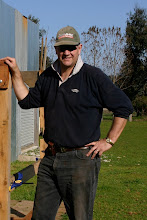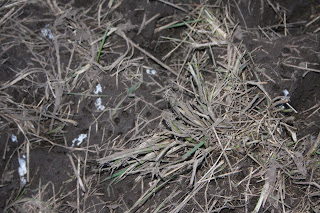S
Ever since I used conventional mechanised means to kick start the transition to high productivity pastures at Moora, I have wondered whether I might have been able to do it without the contractor's 200 HP John Deere, disc plough, and other implements.
But, at the time, I hadn't read Peter Andrews or Joel Salatin - and I hate gorse - of which we had plenty. So I got the most of the place mulched and then burnt before cultivation, lime, 2 years of fodder crops and re-cultivation (to break the weed cycle) ... before planting to a mix of just a couple of pasture species - plus clovers.
I think Moora pastures are now pretty good, but I'm actively looking to increase the range of species in the pasture sward with hand oversowing - and also just seeing what volunteers (and performs) under the cell grazing regime we now operate to. After reading Peter Andrews, in particular, I can never look at a 'weed' the same way again.
Leasing another farm nearby has given me an opportunity to try a different approach to improving pasture. We are fortunate enough to have the new farm - of about 60 acres - on a long term basis. So I can afford to put some effort into building its productivity - knowing we will reap the benefit for as many years as I am likely to want to continue farming.
When we took over there was one reasonable quality 10 acre paddock - where we were already grazing stock. The farm included 4 more small paddocks (another 8 acres) and a big area (40 acres) with little grass and a
lot of hungry kangaroos in residence. This area had been fenced, but at some stage this had fallen into disrepair. My first thought was to just lease the fenced paddocks, but this was not attractive to the owner. In the end I took on the big paddock as well.
When it started raining again in winter of 2010 the response in that big paddock was pretty impressive - and a bit unexpected. By the end of that summer, I was in charge and it was necessary too slash the huge quantity of grass and weeds. It took a contractor several days to grind his way through it all and the mulched grass lay thick on the ground.
During the winter I had an electric fence built to separate my area off from the part of the property I'm not leasing. It's a 4 wire fence - 2 of them electrified. Various pundits predicted the kangaroos would destroy the fence, but it hasn't happened in the 6 months it has been there. Perhaps because of plenty of feed in the bush - or the long grass - we seem to have far fewer kangaroos. Long may it continue.
We've had another good year and the grass (with fewer weeds this time) was well over a metre deep across most of the big paddock by late Spring. My holiday job has been to create an electric fenced sub-divsion - and to start the process of cattle led pasture improvement. I have a mob of 19 steers on it and they are working their way through it.
In the spring they were getting about a 1/6th of an acre a day. With the deteriorating quality of the pasture now, I'm giving them about 1/4 of an acre. There is a lot of Phalaris and it's long and has seeded. They are trampling a fair bit of it now, but look well and seem to be gaining weight.
I've now finished feeding 2 of the 7 paddocks that the fencing has created. I'll keep two of these as 'set stocking' rest areas. The other 5 - I'm going to really try to improve pasture productivity. The first of these, I finished feeding at the end of November. It is now greening up and coming back nicely.
The second paddock was very long and rank before the steers went in - and had more weeds. When they finished, I decided to use my big zero turn mower to slash the residual. The first photo shows slashed and unslashed areas side by side.
The second photo shows the southern half of the paddock after I finished - and the last one the northern half.
The slashing creates more organic material to go with the mulched pasture from last year. It also knocks down the weeds - a mix of dock, thistles, wire weed and another woody thing that the cattle seem to strip bare. They don't touch the dock, thistles or wire weed. We do a certain amount of grubbing, but mainly we're going to use the Peter Andrew's approach and see what happens with cell grazing and a bit of natural fertility enhancement.
Mowing it gives me a good look at the paddock - where grass is growing well - and where it's thinner. This, and the fencing, tells me that I've got quite a bit of really productive land - at least when it rains. Not all of it is good - but I think the poor spots are probably only about 15% of the 40 acres. The rest looks as though it's as good as (or better than) the best of Moora.
When I finished it this evening it looked pretty good. I'm thinking of getting a really big lot of the chicken manure and rice hulls that I've been using at Moora and using my manure spreader to put that out. It has made a big difference at Moora - where I've spread it. I just got 22 m3 a few days ago - and most of that will go onto 43 this weekend. The rest will be used to turbo charge the compost heaps.
F

















